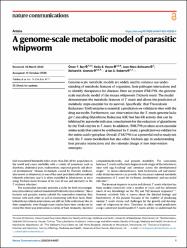| dc.contributor.author | Bay, Ömer F. | |
| dc.contributor.author | Hayes, 3, Kelly S. | |
| dc.contributor.author | Schwartz, Jean-Marc | |
| dc.contributor.author | Grencis, Richard K. | |
| dc.contributor.author | Roberts, Ian S. | |
| dc.date.accessioned | 2024-02-01T13:05:30Z | |
| dc.date.available | 2024-02-01T13:05:30Z | |
| dc.date.issued | 2023 | en_US |
| dc.identifier.issn | 2041-1723 | |
| dc.identifier.other | WOS:001094448600026 | |
| dc.identifier.uri | https://doi.org/10.1038/s41467-023-42552-4 | |
| dc.identifier.uri | https://hdl.handle.net/20.500.12573/1912 | |
| dc.description.abstract | Genome-scale metabolic models are widely used to enhance our understanding of metabolic features of organisms, host-pathogen interactions and to identify therapeutics for diseases. Here we present iTMU798, the genome-scale metabolic model of the mouse whipworm Trichuris muris. The model demonstrates the metabolic features of T. muris and allows the prediction of metabolic steps essential for its survival. Specifically, that Thioredoxin Reductase (TrxR) enzyme is essential, a prediction we validate in vitro with the drug auranofin. Furthermore, our observation that the T. muris genome lacks gsr-1 encoding Glutathione Reductase (GR) but has GR activity that can be inhibited by auranofin indicates a mechanism for the reduction of glutathione by the TrxR enzyme in T. muris. In addition, iTMU798 predicts seven essential amino acids that cannot be synthesised by T. muris, a prediction we validate for the amino acid tryptophan. Overall, iTMU798 is as a powerful tool to study not only the T. muris metabolism but also other Trichuris spp. in understanding host parasite interactions and the rationale design of new intervention strategies.
In this work, Bay et al describe the construction of the first genome-scale metabolic model for the parasitic whipworm, Trichuris muris and use it to identify novel metabolic pathways and predict critical enzymes and essential metabolites for worm survival. | en_US |
| dc.description.sponsorship | Wellcome Trus Z10661/Z/18/Z. | en_US |
| dc.language.iso | eng | en_US |
| dc.publisher | NATURE PORTFOLIO | en_US |
| dc.relation.isversionof | 10.1038/s41467-023-42552-4 | en_US |
| dc.rights | info:eu-repo/semantics/openAccess | en_US |
| dc.subject | THIOREDOXIN GLUTATHIONE-REDUCTASE | en_US |
| dc.subject | KNOWLEDGEBASE | en_US |
| dc.subject | MANSONI | en_US |
| dc.subject | DRUG | en_US |
| dc.title | A genome-scale metabolic model of parasitic whipworm | en_US |
| dc.type | article | en_US |
| dc.contributor.department | AGÜ, Mühendislik Fakültesi, Elektrik - Elektronik Mühendisliği Bölümü | en_US |
| dc.contributor.authorID | 0000-0002-1142-2204 | en_US |
| dc.contributor.institutionauthor | Bay, Ömer F. | |
| dc.identifier.volume | 14 | en_US |
| dc.identifier.issue | 1 | en_US |
| dc.identifier.startpage | 1 | en_US |
| dc.identifier.endpage | 10 | en_US |
| dc.relation.journal | NATURE COMMUNICATIONS | en_US |
| dc.relation.publicationcategory | Makale - Uluslararası Hakemli Dergi - Kurum Öğretim Elemanı | en_US |


















